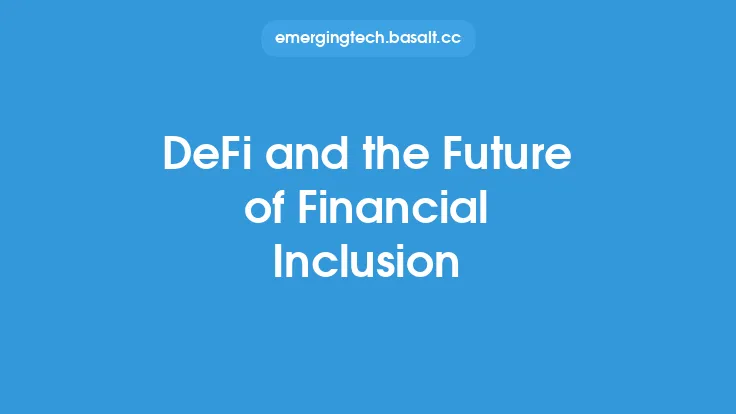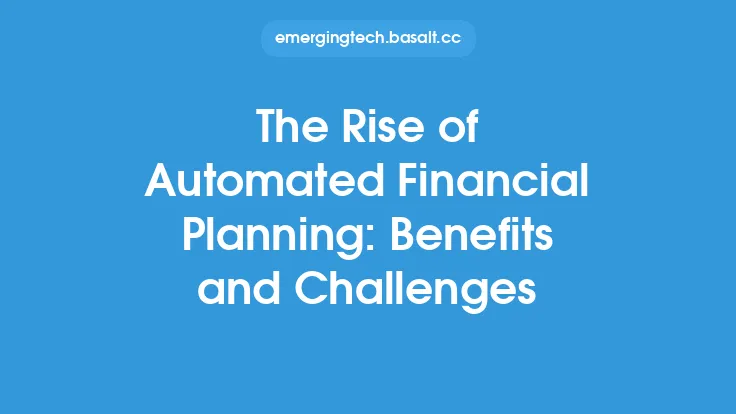The concept of financial inclusion has been gaining significant attention in recent years, as it is widely recognized as a crucial factor in promoting economic growth, reducing poverty, and improving living standards. Financial inclusion refers to the access to and usage of formal financial services, such as banking, credit, and insurance, by individuals and businesses. However, a significant portion of the global population remains excluded from these services, often due to lack of access, affordability, or awareness. Expanding access to financial services is essential to address this issue and promote financial inclusion.
Introduction to Financial Inclusion
Financial inclusion is a multifaceted concept that encompasses various aspects, including access to financial services, usage of financial products, and the quality of these services. It is essential to understand that financial inclusion is not just about providing access to financial services, but also about ensuring that these services are affordable, convenient, and tailored to the needs of the users. The benefits of financial inclusion are numerous, including increased economic opportunities, improved financial stability, and enhanced overall well-being.
The Role of Technology in Expanding Access to Financial Services
Technology has been a key driver in expanding access to financial services, particularly in developing countries. The widespread adoption of mobile phones and the internet has enabled the development of digital financial services, such as mobile banking, online lending, and digital payments. These services have made it possible for people to access financial services remotely, reducing the need for physical infrastructure and increasing convenience. Additionally, technology has enabled the use of alternative data sources, such as social media and mobile phone usage, to assess creditworthiness and provide financial services to underserved populations.
Digital Payments and Financial Inclusion
Digital payments have been instrumental in promoting financial inclusion, particularly in countries with underdeveloped banking systems. Digital payment systems, such as mobile money and online payment platforms, have enabled people to make transactions without the need for physical cash or traditional banking infrastructure. These systems have also facilitated the development of new financial products, such as microloans and microsavings, which are tailored to the needs of low-income individuals. Furthermore, digital payments have increased financial security and reduced the risk of theft and loss associated with cash transactions.
The Importance of Financial Literacy
Financial literacy is a critical component of financial inclusion, as it enables individuals to make informed decisions about their financial lives. Financial literacy refers to the ability to understand and manage personal finances, including budgeting, saving, and investing. It is essential to provide financial education and training to individuals, particularly in underserved communities, to empower them to take control of their financial lives. Financial literacy programs can be delivered through various channels, including schools, community centers, and online platforms.
The Role of Regulation in Promoting Financial Inclusion
Regulation plays a crucial role in promoting financial inclusion, as it provides a framework for the development of financial services and protects consumers from exploitation. Regulatory bodies can create an enabling environment for financial inclusion by implementing policies that promote access to financial services, reduce costs, and increase competition. Additionally, regulation can help to mitigate risks associated with financial services, such as fraud and money laundering, and ensure that financial institutions operate in a safe and sound manner.
The Future of Financial Inclusion
The future of financial inclusion is promising, with technological advancements and innovative business models continuing to expand access to financial services. The use of artificial intelligence, blockchain, and the Internet of Things (IoT) is expected to further enhance financial inclusion, particularly in areas such as credit scoring, identity verification, and payment systems. Additionally, the development of new financial products, such as microinsurance and micropensions, is expected to provide greater financial security and stability to underserved populations.
Challenges and Opportunities
Despite the progress made in promoting financial inclusion, there are still significant challenges to be addressed. These challenges include the lack of access to financial services in rural areas, the high cost of financial services, and the limited availability of financial products tailored to the needs of low-income individuals. However, these challenges also present opportunities for innovation and growth, particularly in the development of new financial products and services that cater to the needs of underserved populations.
Conclusion
Expanding access to financial services is essential to promote financial inclusion and address the needs of underserved populations. Technology, digital payments, financial literacy, and regulation are all critical components of financial inclusion, and their development and implementation will continue to shape the future of financial services. As the financial landscape continues to evolve, it is essential to prioritize financial inclusion and ensure that all individuals have access to affordable, convenient, and tailored financial services. By doing so, we can promote economic growth, reduce poverty, and improve living standards, ultimately creating a more equitable and prosperous society for all.





